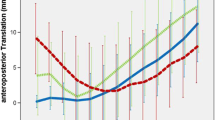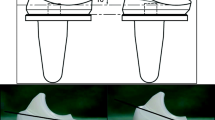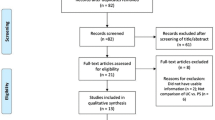Abstract
Purpose
Stiffness is a common problem following total knee arthroplasty (TKA). Mal-rotated components have been claimed to be the major cause of pain and limited motion after TKA. The present study investigates whether intra-operative intentional malrotation of the tibial component would change in vivo kinematics. The hypothesis is excessive internal rotation of the tibial component would result in postoperative extension deficit.
Methods
Thirty-one patients were enrolled in this study. After completing bony cuts and proper soft tissue balancing, the femoral and tibial trials were impacted and fixed using small pins. Lateral radiographs were used to measure and compare intraoperative full knee extension during normal and after intentional internal rotation of the tibial component. The extension deficit angles were also compared between the posterior stabilised (PS) and cruciate retaining (CR) implants.
Results
For normal tibial component rotation, the median (interquartile range) extension deficit was 0° (4). The mean tibial trial intentional internal rotation was 21.2° (± 4.5). The median (interquartile range) extension deficit significantly increased to 6° (4) after tibial component internal rotation (p = 0.001). The use of PS spacers resulted in a significantly greater extension deficit after intentional internal rotation 9° (5) compared to that of the CR implant 1° (4) (p = 0.001).
Conclusion
Internal rotation of the tibial component in total knee arthroplasty can lead to postoperative extension deficit. This could be attributed to interference with “screw home” mechanism that requires full external rotation of the tibia on the femur. Consequently, this deficit may cause pain and knee stiffness following TKA.
Level of evidence
III.

Similar content being viewed by others
References
Akagi M, Mori S, Nishimura S, Nishimura A, Asano T, Hamanishi C (2005) Variability of extraarticular tibial rotation references for total knee arthroplasty. Clin Orthop Relat Res 436:172–176
Barrack RL, Schrader T, Bertot AJ, Wolfe MW, Myers L (2001) Component rotation and anterior knee pain after total knee arthroplasty. Clin Orthop Relat Res 392:46–55
Bedard M, Vince KG, Redfern J, Collen SR (2011) Internal rotation of the tibial component is frequent in stiff total knee arthroplasty. Clin Orthop Relat Res 469:2346–2355
Benjamin J (2006) Component alignment in total knee arthroplasty. Instr Course Lect 55:405–412
Berger RA, Crossett LS, Jacobs JJ, Rubash HE (1998) Malrotation causing patellofemoral complications after total knee arthroplasty. Clin Orthop Relat Res 356:144–153
Berger RA, Rubash HE (2001) Rotational instability and malrotation after total knee arthroplasty. Orthop Clin N Am 32(639–647):ix
Berhouet J, Beaufils P, Boisrenoult P, Frasca D, Pujol N (2011) Rotational positioning of the tibial tray in total knee arthroplasty: a CT evaluation. Orthop Traumatol Surg Res 97:699–704
Bonnin MP, Saffarini M, Mercier PE, Laurent JR, Carrillon Y (2011) Is the anterior tibial tuberosity a reliable rotational landmark for the tibial component in total knee arthroplasty? J Arthroplasty 26(260–267):e261–262
Bytyqi D, Shabani B, Lustig S, Cheze L, Karahoda Gjurgjeala N, Neyret P (2014) Gait knee kinematic alterations in medial osteoarthritis: three dimensional assessment. Int Orthop 38:1191–1198
Clement ND, Bardgett M, Weir D, Holland J, Deehan DJ (2018) Increased symptoms of stiffness 1 year after total knee arthroplasty are associated with a worse functional outcome and lower rate of patient satisfaction. Knee Surg Sports Traumatol Arthrosc 4:1196–1203
Cobb JP, Dixon H, Dandachli W, Iranpour F (2008) The anatomical tibial axis: reliable rotational orientation in knee replacement. J Bone Jt Surg Br 90:1032–1038
Coughlin KM, Incavo SJ, Churchill DL, Beynnon BD (2003) Tibial axis and patellar position relative to the femoral epicondylar axis during squatting. J Arthroplasty 18:1048–1055
Dai Y, Scuderi GR, Bischoff JE, Bertin K, Tarabichi S, Rajgopal A (2014) Anatomic tibial component design can increase tibial coverage and rotational alignment accuracy: a comparison of six contemporary designs. Knee Surg Sports Traumatol Arthrosc 22:2911–2923
Edwards JZ, Greene KA, Davis RS, Kovacik MW, Noe DA, Askew MJ (2004) Measuring flexion in knee arthroplasty patients. J Arthroplasty 19:369–372
Heyse TJ, El-Zayat BF, De Corte R, Chevalier Y, Fuchs-Winkelmann S, Labey L (2018) Internal femoral component malrotation in TKA significantly alters tibiofemoral kinematics. Knee Surg Sports Traumatol Arthrosc 26:1767–1775
Kim HY, Kim KJ, Yang DS, Jeung SW, Choi HG, Choy WS (2015) Screw-home movement of the tibiofemoral joint during normal gait: three-dimensional analysis. Clin Orthop Surg 7:303–309
Kuriyama S, Ishikawa M, Furu M, Ito H, Matsuda S (2014) Malrotated tibial component increases medial collateral ligament tension in total knee arthroplasty. J Orthop Res 32:1658–1666
Lutzner J, Krummenauer F, Gunther KP, Kirschner S (2010) Rotational alignment of the tibial component in total knee arthroplasty is better at the medial third of tibial tuberosity than at the medial border. BMC Musculoskelet Disord 11:57
Martin S, Saurez A, Ismaily S, Ashfaq K, Noble P, Incavo SJ (2014) Maximizing tibial coverage is detrimental to proper rotational alignment. Clin Orthop Relat Res 472:121–125
Matsuda S, Miura H, Nagamine R, Urabe K, Hirata G, Iwamoto Y (2001) Effect of femoral and tibial component position on patellar tracking following total knee arthroplasty: 10-year follow-up of Miller-Galante I knees. Am J Knee Surg 14:152–156
Matsuda S, White SE, Williams VG 2nd, McCarthy DS, Whiteside LA (1998) Contact stress analysis in meniscal bearing total knee arthroplasty. J Arthroplasty 13:699–706
Minoda Y, Ikebuchi M, Mizokawa S, Ohta Y, Nakamura H (2018) Asymmetric tibial component improved the coverage and rotation of the tibial component in a medial pivot total knee prosthesis. J Knee Surg 31:416–421
Nicoll D, Rowley DI (2010) Internal rotational error of the tibial component is a major cause of pain after total knee replacement. J Bone Jt Surg Br 92:1238–1244
Panni AS, Ascione F, Rossini M, Braile A, Corona K, Vasso M et al (2018) Tibial internal rotation negatively affects clinical outcomes in total knee arthroplasty: a systematic review. Knee Surg Sports Traumatol Arthrosc 26:1636–1644
Parvizi J, Tarity TD, Steinbeck MJ, Politi RG, Joshi A, Purtill JJ et al (2006) Management of stiffness following total knee arthroplasty. J Bone Jt Surg Am 88(Suppl 4):175–181
Scuderi GR (2005) The stiff total knee arthroplasty: causality and solution. J Arthroplasty 20:23–26
Steinbruck A, Schroder C, Woiczinski M, Muller T, Muller PE, Jansson V et al (2016) Influence of tibial rotation in total knee arthroplasty on knee kinematics and retropatellar pressure: an in vitro study. Knee Surg Sports Traumatol Arthrosc 24:2395–2401
Yercan HS, Sugun TS, Bussiere C, Ait Si Selmi T, Davies A, Neyret P (2006) Stiffness after total knee arthroplasty: prevalence, management and outcomes. Knee 13:111–117
Funding
No funding has been received for this study.
Author information
Authors and Affiliations
Corresponding author
Ethics declarations
Conflict of interest
The authors declare that they have no conflicts of interest.
Ethical approval
This present study obtained approval from the Local Institutional Ethical Committee of Burjeel Hospital for Advanced Surgery (IRB no. E10022).
Informed consent
Informed consent was obtained from patients.
Additional information
Publisher's Note
Springer Nature remains neutral with regard to jurisdictional claims in published maps and institutional affiliations.
Rights and permissions
About this article
Cite this article
Abdelnasser, M.K., Adi, M.M., Elnaggar, A.A. et al. Internal rotation of the tibial component in total knee arthroplasty can lead to extension deficit. Knee Surg Sports Traumatol Arthrosc 28, 2948–2952 (2020). https://doi.org/10.1007/s00167-019-05695-w
Received:
Accepted:
Published:
Issue Date:
DOI: https://doi.org/10.1007/s00167-019-05695-w




